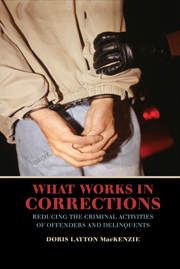Book contents
- Frontmatter
- Contents
- Acknowledgments
- PART ONE STRATEGIES FOR REDUCING CRIME
- PART TWO THE EFFECTIVENESS OF REHABILITATION PROGRAMS
- 5 Academic Education and Life Skills Programs
- 6 Vocational Education and Work Programs
- 7 Cognitive Behavioral Therapy Programs
- PART THREE TARGETING SPECIFIC TYPES OF OFFENDERS
- PART FOUR MANAGEMENT AND TREATMENT OF SUBSTANCE ABUSERS
- PART FIVE CONTROL, DISCIPLINE, AND PUNISHMENT
- PART SIX CONCLUSIONS
- References
- Index
- CAMBRIDGE STUDIES IN CRIMINOLOGY
5 - Academic Education and Life Skills Programs
Published online by Cambridge University Press: 27 July 2009
- Frontmatter
- Contents
- Acknowledgments
- PART ONE STRATEGIES FOR REDUCING CRIME
- PART TWO THE EFFECTIVENESS OF REHABILITATION PROGRAMS
- 5 Academic Education and Life Skills Programs
- 6 Vocational Education and Work Programs
- 7 Cognitive Behavioral Therapy Programs
- PART THREE TARGETING SPECIFIC TYPES OF OFFENDERS
- PART FOUR MANAGEMENT AND TREATMENT OF SUBSTANCE ABUSERS
- PART FIVE CONTROL, DISCIPLINE, AND PUNISHMENT
- PART SIX CONCLUSIONS
- References
- Index
- CAMBRIDGE STUDIES IN CRIMINOLOGY
Summary
INTRODUCTION
Educational programming in prisons originally focused on religious instruction. Such instruction was expected to help offenders achieve spiritual enlightenment (Gerber & Fritsch, 1995; Teeters, 1955). Consistent with the beliefs of those responsible for the early penitentiary movement, offenders were thought to need time to reflect on their crimes and repent. Religious instruction was expected to help in this process of penitence. However, during the reformatory era, the focus of education programs changed from religious instruction to basic literacy and communication skills.
The reformatory age began in 1876 when Zebulon R. Brockway first proposed his theory of rehabilitation at the first conference of the American Prison Association (the forerunner of the current American Correctional Association). Since that time academic education has been a cornerstone of correctional programming. As superintendent of the first reformatory at Elmira, New York, Brockway brought his revolutionary ideas into practice. The goal was to reform youth. The reformatory was designed to provide a physically and mentally healthy environment where youth would have access to academic education and extensive vocational training. Brockway believed that law-abiding behavior was attainable through legitimate industry and education (Reagan & Stoughton, 1976). Elmira was used as a model for both adult prisons and juvenile reformatories throughout the United States.
During the age of rehabilitation, from the turn of the century until the mid-1970s, educational programs were considered a mainstay of correctional rehabilitation.
- Type
- Chapter
- Information
- What Works in CorrectionsReducing the Criminal Activities of Offenders and Deliquents, pp. 69 - 89Publisher: Cambridge University PressPrint publication year: 2006



